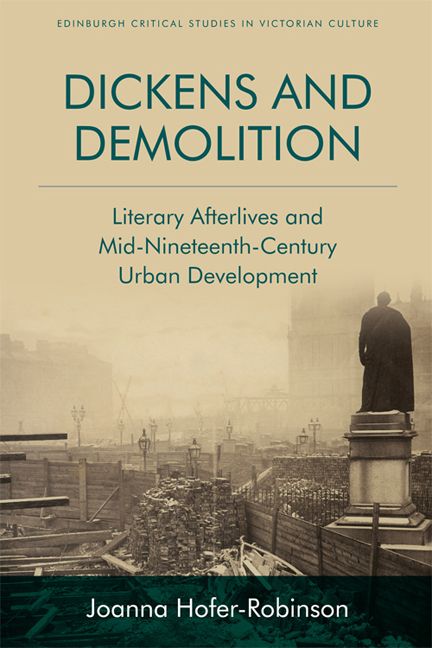Book contents
- Frontmatter
- Contents
- List of Illustration
- Acknowledgements
- Series Editor’s Preface
- Abbreviations and a Note on Editions
- Dedication
- Introduction
- 1 Charles Dickens and Metropolitan Improvements
- 2 Sets and the City: Staging London and Oliver Twist
- 3 Dickensian Afterlives and the Demolition of Field Lane
- 4 Paperwork and Philanthropy: Dickens’s Involvement in Metropolitan Improvement
- 5 From Sanit ary Reform to Cultural Memory: The Case of Jacob’s Island
- Coda
- Archival Sources and a Note on Method
- Select Bibliography
- Index
- Plate Section
5 - From Sanit ary Reform to Cultural Memory: The Case of Jacob’s Island
Published online by Cambridge University Press: 29 April 2021
- Frontmatter
- Contents
- List of Illustration
- Acknowledgements
- Series Editor’s Preface
- Abbreviations and a Note on Editions
- Dedication
- Introduction
- 1 Charles Dickens and Metropolitan Improvements
- 2 Sets and the City: Staging London and Oliver Twist
- 3 Dickensian Afterlives and the Demolition of Field Lane
- 4 Paperwork and Philanthropy: Dickens’s Involvement in Metropolitan Improvement
- 5 From Sanit ary Reform to Cultural Memory: The Case of Jacob’s Island
- Coda
- Archival Sources and a Note on Method
- Select Bibliography
- Index
- Plate Section
Summary
Repurposed nineteenth-century warehouses, mid-twentieth-century social housing and twenty-first-century flats and offices now occupy Jacob's Island: the site that Charles Dickens describes in Oliver Twist (1837–9) as ‘the filthiest, the strangest, the most extraordinary of the many localities that are hidden in London’ (OT, p. 416). Even the topography has changed. The tidal waterways that previously surrounded the district have been filled in (Figure 5.1). One accessed the site by crossing rickety wooden bridges, and, once inside, streams and canals further cross-sectioned this ‘small but densely populated place’. The inlets from the Thames formerly served an industry of water mills, but by the time that Dickens made Jacob's Island the setting for Bill Sikes's death these waterways had become open sewers that received the inhabitants’ household waste and effluvia. It is also likely that the water would have been contaminated by adjacent tanneries (Figure 5.2). The use of manure during the manufacture of leather would have at least exacerbated its already malodorous conditions. Off the beaten track, and long neglected by civic bodies, Dickens even claims that Jacob's Island is ‘wholly unknown, even by name, to the great mass of [London’s] inhabitants’ (OT, p. 416).
Jacob's Island was far from obscure by the mid-nineteenth century, however. During the 1840s the district was repeatedly investigated by social explorers, and by the 1850s it had adopted an almost symbolic significance in parliamentary and committee debates about metropolitan sanitary reform. Lord Ashley (later Shaftsbury) singled out Jacob's Island in a discussion about the ‘Sanitary State of the Metropolis’ in 1852, for instance, calling it a ‘famous place […] of a most disgusting description’. In the popular press, too, references to Jacob's Island connoted dangerously insanitary conditions. For, having been linked to outbreaks of cholera in 1832 and 1848, and named ‘the very capital of cholera’ by Henry Mayhew, Jacob's Island represented a threat to London as a whole. Although how disease spread was still improperly understood, leading sanitary reformers, such as Edwin Chadwick, stressed that improvement of living conditions was vital to combating public health issues associated with poor sanitation and contaminated water successfully.
- Type
- Chapter
- Information
- Dickens and DemolitionLiterary Afterlives and Mid-Nineteenth Century Urban Development, pp. 173 - 206Publisher: Edinburgh University PressPrint publication year: 2018

